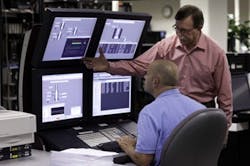Optimize Control System Migration
In today's tough business environment, many chemical plants view upgrading their process control systems as an important step toward improved competitiveness. After all, a control system can hugely impact performance over the entire lifecycle of a facility. Still, of course, the replacement system must offer a superior business-value proposition.
A well-planned and executed migration to a modern control system not only improves plant availability and reliability but also can provide a more flexible production platform. Many companies now are looking for increased flexibility so they can make the most of business opportunities.
A structured, organized approach to automation upgrades enhances the benefits of new technology, reduces risks and preserves valuable intellectual property.
So, here, we'll provide tips for optimizing migrations. The goal is to help plants accelerate the migration process, minimize potential complications and ensure successful project results. These insights have been gained from experience with migrations at plants of all types and sizes, and with a wide range of operational and business requirements.
THE INCENTIVES
Every distributed control system (DCS) at some point requires upgrading to maintain reliable operation and leverage the latest technology. The existing DCS may pose significant maintenance issues, which can be aggravated by problems in obtaining spare parts. It also can be difficult to find personnel qualified to troubleshoot and repair an older system. As plant workers familiar with the current DCS reach retirement age, outside support often becomes necessary.
Excessive failure rates, difficultly in procuring spare parts and lack of qualified maintenance personnel all add up to an increased risk of downtime —a significant expense for any manufacturing facility, but particularly for a process plant.
[Podcasts Worth Listening To: Leadership Focus Podcast: Control System Migration and Podcast: Book Review -- Control System Migrations Handbook]
In addition, process control with an outdated DCS may result in inadequate quality and excessive energy usage. Deviations from set points, particularly for extended periods of time, can directly impair quality. Control performance also can affect throughput. Newer automation platforms allow automating more processes and can enable tighter control of existing ones.
Today, many control system migrations are performed "on-process," using technology that replaces the existing human-machine interfaces (HMIs) and provides modern functions while retaining the original system's controllers, input/output and field devices. With this approach, all or part of the old DCS and the new automation system operate simultaneously, allowing elements as small as one control loop at a time to be migrated from the old DCS to the new automation system. If the user has a redundant control architecture, on-process migration permits an upgrade to the next system release while maintaining view and control of processes.
INITIAL PLANNING
The first step in preparing for a control system migration is developing a comprehensive project plan. This involves working with all stakeholders —including operations, engineering and plant management — to align on scope, risk assessment and the overall project roadmap. Project participants should evaluate and prioritize what's important from their individual perspectives. This helps to create ownership and a shared vision throughout the organization.
Among key factors to consider at the project planning stage are:
• establishing specific goals for your upgrade;
• developing an organized approach to planning;
• determining how you will build your new system;
• communicating with operations, management and outside support personnel;
• remembering that a migration primarily consists of sequential operations (skipping a step could result in putting yourself in a precarious position); and
• retaining focus on your plan.
In the early stages of a control system migration, the project team should identify the primary objectives for technology upgrades. These may include:
• increased control system reliability;
• reduced risk;
• enhanced alarming functionality;
• improved utilization of historical data;
• expanded access to DCS information from third-party systems;
• heightened overall intercommunications; and
• strengthened security capabilities (often overlooked).
Figure 1. Migration success often hinges on working closely with vendor specialists during initial preparation.
Figure 2. Maintain close contact with plant operations staff during on-process migration.
Figure 3. Installing new hardware at the same time as migration simplifies the process.
CHRISTOPHER PETERS is a Richmond, Va.-based consultant for HPS Lifecycle Solutions and Services Americas. E-mail him at [email protected].





